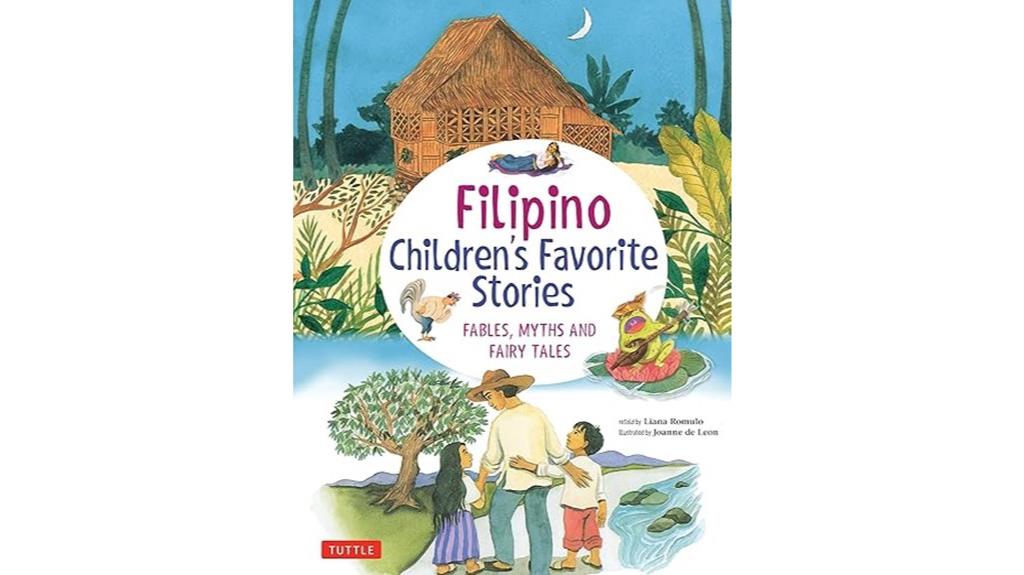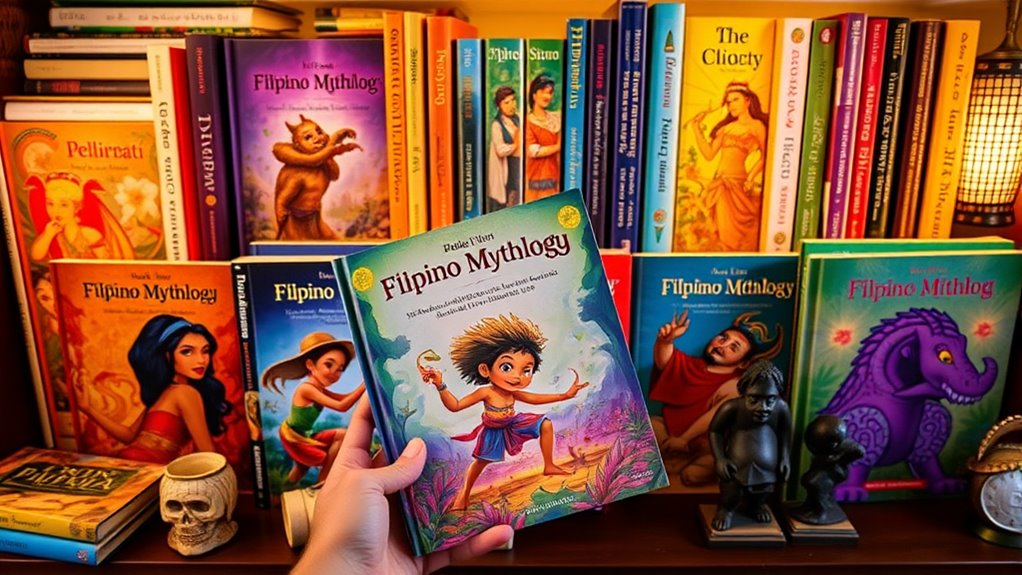If you want to enrich your child’s cultural understanding, the best Filipino mythology storybook for your shelf right now is a collection of beloved tales like “Why Mosquitoes Buzz Around Our Ears.” It engages kids aged 5 to 10 with its whimsical illustrations and timeless moral lessons on good versus evil. By introducing these stories, you’ll foster cultural appreciation and pride in Filipino heritage. Curious about how these narratives can impact your child’s values? Let’s explore further.
Key Takeaways
- The storybook features engaging Filipino folklore that introduces children to cultural heritage and timeless moral lessons.
- Whimsical illustrations by award-winning artist Joanne de Leon enhance the storytelling experience, captivating young readers.
- Ideal for children aged 5 to 10, it fosters cultural appreciation and encourages pride in Filipino identity.
- Classic themes of good versus evil, cleverness, and resilience resonate with children, promoting empathy and critical thinking.
- While primarily focused on Filipino tales, its rich narratives provide valuable insights into traditional values and beliefs.
Filipino Children’s Favorite Stories: Fables, Myths and Fairy Tales

If you’re a parent wanting to introduce your child to Filipino culture, the “Filipino Mythology Storybook” is the perfect choice. This collection features beloved tales like “Why Mosquitoes Buzz Around Our Ears” and “The Deer and the Snail,” enchanting kids aged 5 to 10. Each story highlights themes of good versus evil and cleverness, helping children appreciate moral lessons. With whimsical illustrations by award-winning artist Joanne de Leon, the reading experience is visually delightful. Many parents rave about its engaging narratives, making it a favorite for bedtime. This book truly connects children to their Filipino heritage and fosters cultural appreciation.
Best For: Parents wanting to introduce their children to Filipino culture and folklore through engaging stories.
Pros:
- Engaging narratives that captivate young readers and promote cultural appreciation.
- Whimsical illustrations by award-winning artist Joanne de Leon enhance the storytelling experience.
- Teaches valuable moral lessons through timeless themes of good versus evil and cleverness.
Cons:
- Some story endings may feel abrupt and lack depth in moral lessons.
- Limited to tales from Filipino culture, which may not appeal to those seeking a broader range of stories.
- Primarily targeted at a specific age group (5 to 10 years), potentially excluding older children.
Factors to Consider When Choosing Filipino Mythology Storybooks

When I’m picking out Filipino mythology storybooks, I always think about a few key factors. Age appropriateness is essential, as well as the cultural authenticity of the tales. I also pay attention to the quality of illustrations, the moral lessons they convey, and the storytelling style to guarantee an engaging read.
Age Appropriateness
Choosing the right Filipino mythology storybook for children involves careful consideration of age appropriateness. I always look for the target age range, as many stories are tailored for kids aged 5 to 10, which guarantees they can fully engage with the tales. It’s also essential to check the themes and moral lessons, making certain they align with the child’s understanding of good versus evil. I evaluate the language complexity too; younger children thrive on simpler vocabulary, while older ones can appreciate more intricate plots. Additionally, I assess the illustrations, as enchanting visuals greatly enhance comprehension for younger readers. Finally, I value parental feedback, as it can guide me in choosing stories that truly resonate with the intended age group.
Cultural Authenticity
Ensuring cultural authenticity is crucial in selecting Filipino mythology storybooks that truly resonate with readers. I look for stories that authentically represent traditional narratives and folklore, preserving the rich cultural integrity of the Philippines. It’s essential to choose books that showcase a diverse range of myths from various regions, reflecting our unique heritage. Authenticity shines through in the inclusion of culturally significant characters, themes, and moral lessons that resonate with Filipino values. I also consider the author’s background and expertise in Filipino culture, as this enhances the storytelling’s credibility. While I won’t explore illustrations just yet, I believe they should reflect cultural elements to further engage the reader and enrich the overall experience.
Illustrations Quality
Cultural authenticity is essential, but the visual aspect of Filipino mythology storybooks can’t be overlooked. High-quality illustrations, like whimsical watercolors, really enhance the storytelling experience and draw young readers in. When the artwork is well-crafted, it conveys cultural elements and themes, making the stories more relatable for children. Bright colors and imaginative designs can captivate their attention, sparking a love for reading. I’ve found that storybooks illustrated by award-winning artists often boast a level of professionalism and creativity that elevates the overall appeal. Plus, illustrations that align with the narrative aid comprehension and retention, ensuring that the rich lessons of Filipino myths resonate long after the pages are closed. So, consider the illustrations carefully!
Moral Lessons
While exploring Filipino mythology storybooks, I always look for the valuable moral lessons embedded within the tales. These stories often focus on the classic themes of good versus evil, emphasizing the importance of ethical behavior and decision-making. For instance, tales like “Why Mosquitoes Buzz Around Our Ears” teach children about the consequences of their actions and the significance of honesty and responsibility. I love how these narratives showcase cleverness and resilience, illustrating that intelligence and perseverance can triumph over adversity. Additionally, by engaging with these stories, children not only learn about their cultural heritage but also reflect on their own values and behaviors. This fosters critical thinking and empathy, making the lessons even more impactful.
Storytelling Style
When I choose Filipino mythology storybooks, I pay close attention to the storytelling style because it greatly impacts the reading experience. I love how these stories often embrace vibrant, engaging narratives that reflect oral traditions, making the tales feel interactive and alive. The themes of good versus evil, cleverness, and resilience resonate deeply, offering moral lessons that connect with childhood experiences. I appreciate the rhythmic and lyrical presentation, perfect for read-aloud sessions that strengthen bonds between parents and children. The whimsical, culturally relevant illustrations also enhance engagement, helping me visualize the narratives. With various storytelling styles, from straightforward retellings to elaborate adaptations, I can find the perfect fit for different age groups and comprehension levels.
Length of Stories
Selecting the right length of stories is just as important as considering the storytelling style. I’ve noticed that Filipino mythology tales vary greatly in length, from a few paragraphs to several pages. For younger readers, shorter stories usually focus on a single moral lesson, making them easier to digest and remember. In contrast, longer narratives can offer richer context and character development but may require more sustained attention, especially for kids aged 5 to 10. I always keep my child’s attention span and interest in mind when choosing stories; shorter tales often work better for bedtime or quick storytelling sessions. The pacing and structure of these stories can also greatly influence how effectively the moral lessons are conveyed and understood.
Author’s Background
Choosing the right Filipino mythology storybook hinges considerably on the author’s background. I always look for authors who have a deep connection to Filipino culture and folklore, as their knowledge often adds authenticity to the stories. Those with strong academic or experiential ties tend to weave traditional themes and moral lessons seamlessly into their narratives. Recognized authors within the Filipino literary community or those who’ve won accolades for children’s literature typically deliver higher quality storytelling. I also appreciate authors who engage with oral traditions, providing a vivid narrative style that captures the essence of folklore. Finally, an author’s ability to connect with young readers through relatable themes and age-appropriate language can make the stories more enjoyable and impactful for children.
Recommended Age Range
Understanding the recommended age range for Filipino mythology storybooks is essential to guarantee that young readers connect with the material. Typically, these books cater to children aged 5 to 10 years old. For younger kids, you’ll find simpler language and shorter narratives, while older children can enjoy more complex stories with deeper character development. Engaging illustrations are vital, as they capture the attention of young readers and bring the tales to life. The themes of good versus evil, cleverness, and resilience resonate well with children in this age group. By choosing the right storybooks, parents can instill cultural appreciation and awareness, helping their children connect with their Filipino heritage in a meaningful way.
Frequently Asked Questions
What Age Group Is Best Suited for Filipino Mythology Storybooks?
When I think about Filipino mythology storybooks, I believe they’re best suited for kids aged 7 to 12. This age group is curious and enthusiastic to explore new cultures and tales. I’ve found that the vibrant stories captivate their imaginations and teach valuable lessons. Plus, the illustrations often draw them in, making reading more enjoyable. If you’ve got young readers at home, introducing them to these stories could spark their love for mythology!
Are There Audio Versions of These Storybooks Available?
Did you know that over 60% of readers prefer audiobooks for their convenience? I’ve found several Filipino mythology storybooks available in audio format, making these enthralling tales even more accessible. It’s great to listen to the rich narratives while multitasking or relaxing. Platforms like Audible and local publishers often feature these audio versions, so if you’re enthusiastic to explore Filipino myths, you can enjoy them on the go!
Can These Stories Be Used for Educational Purposes?
Absolutely, I’ve found that these stories can be incredibly effective for educational purposes. They not only introduce students to Filipino culture and history, but they also spark discussions about moral lessons and values. I’ve used them in my classroom to engage students and encourage critical thinking. Plus, the rich narratives help develop language skills and ignite creativity. So, if you’re considering them for education, I’d say go for it!
How Are Filipino Mythology Stories Different From Other Cultures’ Myths?
Filipino mythology stories really stand out from myths of other cultures because they blend local beliefs with rich traditions. I’ve noticed they often focus on nature, ancestors, and deities that reflect the Filipino spirit. The characters are relatable, showcasing human emotions and struggles. Unlike some Western myths that emphasize heroism, Filipino tales often highlight community and cooperation. This unique perspective offers a deeper understanding of Filipino values and identity, making them truly special.
Where Can I Find Rare or Out-Of-Print Filipino Mythology Storybooks?
Finding rare or out-of-print Filipino mythology storybooks can feel like searching for hidden treasure. I’ve had luck at local used bookstores, where dusty shelves often hold gems. Online, platforms like eBay or AbeBooks can surprise you with unique finds. Don’t overlook library sales; I’ve stumbled upon fantastic collections there. Connecting with fellow enthusiasts in online forums can also lead to valuable leads. Keep your eyes peeled; you never know what you’ll discover!
Conclusion
In wrapping up, I can’t stress enough how important it is to have a vibrant collection of Filipino mythology storybooks on your shelf. They not only spark imagination but also connect you to our rich culture. So, whether you’re sharing tales of Bathala or the mischievous kapre, these stories are timeless treasures. Trust me, you’ll feel like you’re scrolling through a magical Instagram feed of our ancestors’ wisdom with each turn of the page!









